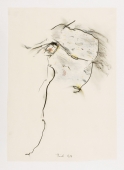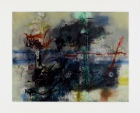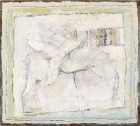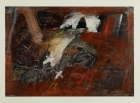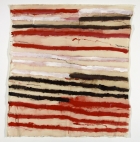Abstract Art 11 – Abstraction As Painterly Rhetoric.
A Case Study Between Germany and China
July 21 - September 2, 2018, PIFO Gallery, Beijing
Curator: Thomas Eller
PIFO Gallery is delighted to present the annual exhibition Abstract Art already in its 11th iteration. This year the gallery brings together artists from China and Germany. Germany has an extraordinarily strong tradition in painterly abstraction, since its founding moment after 1945, leading up to the founding of documenta, Kassel and beyond. Consequently artists from Germany have been a source of reference for many Chinese artists.
The highly influential artist Tan Ping studied in Germany in the early 1990. His paintings are juxtaposed with works by Bernard Schultze (1915 - 2005) and Karl Fred Dahmen (1917 - 1981), who are to be found in all major museums and private collections in Germany. PIFO Gallery is proud to be the first gallery to present their paintings in China.
The exhibition at PIFO gallery brings together some of the most renowned abstract artists in China at present, like Wang Chuan, Zhang Yu and Kang Haitao, who have worked with the gallery for an extended period of time already, with artists from Germany. PIFO gallery has a strong focus on abstraction in art and is the foremost gallery in China in that field.
Abstraction in art is a long, complex and also international affair. Without the influence of Asian art, modernism in Europe and later the USA would never have developed the same way. And reversely, artists in China after the opening up of the country in 1978 have looked at Western art and artists in order to re-connect to contemporary art on a global scale. Interestingly enough a lot of artist have looked at German art, or gone to Germany to study, only to return and start their careers here in China. Two artists in the exhibition have studied in Germany, Tan Ping (1989-94) and He Jian (2005-11). The others are associated to each other and/or the gallery in friendship.
Also presented are six artists from Germany. Two of them, Bernard Schultze and K.F. Dahmen, were part of a founding generation of German artist immediately after the second world war – a moment that was essential in the development of Germany to become a nation of culture again after the disastrous Nazi-period. The rebirth of German art came as a concerted effort that culminated in the creation of documenta.
The younger artists in the exhibition from both countries, China and Germany show that abstraction not only communicates between the different cultural hemispheres, but also connects very different generations. The exhibition demonstrates just how powerful abstraction in painting can still be as artistic practice under the premise of globalization and digitalization and how painterly rhetoric can still be extremely inventive as artistic language.
In essence, the exhibition can be understood as a pilot of sorts for an ongoing investigation into abstraction as contemporary artistic practice on a global scale.
Source: PIFO Gallery
This exhibition on artist-info.com
https://www.artist-info.com/exhibition/PIFO-Gallery-Id380905
Abstract Art 11 – Abstraction As Painterly Rhetoric.
A Case Study Between Germany and China
July 21 - September 2, 2018, PIFO Gallery, Beijing
Curator: Thomas Eller
Abstraction in painting and modernity – both seem to have fallen out of time completely. Modernism is widely viewed today as a Western, colonial phenomenon not designed to include but to overwhelm non-Western cultures. Abstraction in art wanted to be an "international language" for all to partake in but is now regarded as an artistic rhetoric that was defined and controlled by a few proponents in big Western art-hubs, mainly New York, Paris, Cologne/Düsseldorf.
Abstraction has been under suspicion and attack not only in post-colonial discourse. Already with the beginning of the pop art movement in New York in the 1950s, a full-fledged assault from within was launched at AbEx (short for “abstract expressionism” and its old-boys-club). We all know this resulted in a wide array of experimental artistic rhetoric since: minimalism, concept art, installation, happening, performance, etc. to the more research-based art practices today.
All those artistic languages (mostly developed in New York) appear to be acceptable today and around the world – allowing artists to speak about their own issues from their cultural and social backgrounds to a global audience. – Have we now really leveled the cultural playing field?! – Or isn´t it rather that the West has invited everybody to talk about their “issues” – BUT PLEASE – in a language the West deems commensurable!
But isn´t it the language that shapes cultures and societies?!
Back to the issues of modernity and painterly abstraction – Is it really true that both are an imposition by the West on the “rest of the world”?!
Firstly, in China there is a different perspective on this. The 2008 Guangzhou Triennial “Farewell to Post-colonialism”, curated by Gao Shiming and Chang Tzongzung, made the claim that China modernized itself and strongly refuted the notion of China as having been coerced into modernization.
And in fact they have been right. Artists like Xu Beihong brought modern art to China. But the better argument is the development of very strong artistic movements after the opening-up of China in 1978 which continue to powerfully demonstrate their claim on contemporaneousness also in the field of painterly abstraction. Until today there is an intense dialog between ink and wash and abstract oil painting, which has lead many artists in China to define their very own terms about what it means to be contemporary. Be it “modern ink and wash” or “experimental” – each artist engaging in this discussion by making artworks is part of a much larger collective desire to understand better, what it means to be contemporary in China for everyone. In other words … Artist in China are working on developing their own voice in their own language. And it will be interesting just how their rhetoric will evolve in the next future.
Secondly, abstraction didn´t fall from the skies in the West and suddenly appear. Actually a lot of artists since the early days of modernism in Europe and the USA, from Van Gogh to Brice Marden, were quite fascinated and influenced by Asian art and brushwork. They learned a lot from looking at ink wash paintings and calligraphy. Effectively abstraction in art is a two-way street that has seen heavy traffic from either side over the last century, depending on the cultural tidal forces.
The waves of mutual influencing have been wafting back and forth at least once or twice. One of the reasons for this strong current is the fact that abstraction in art is essentially a painterly subject. Every artist knows about the transformation into art that happens, when one handles paint and a brush on paper or canvas. Abstraction is what an artist does on a daily basis … a translation from intention, intuition, intelligence and ignorance into an image.
This series of exhibitions at PIFO gallery is witness and platform for an interrogation of painterly abstraction. This year´s instalment juxtaposes Chinese artists with their counterparts from Germany.
German art has long been a strong reference for artists in China. This exhibition serves as a pilot that flies one route over a vast landscape that remains to be described in more detail. The show touches down a few times to take a closer look at unexpected connections between artists from different cultural backgrounds and even generations. There are some artists that serve as flight controllers. Tan Ping studied in Berlin during Germany´s reunification and He Jian was an assistant at documenta 12 in Kassel. They are pathfinders that provide orientation and at the same time help deepen the discourse of abstraction as an international painterly rhetoric.
Source: ZhongXi e.V. Press Release
artist-info.com Exhibition Page
https://www.artist-info.com/exhibition/PIFO-Gallery-Id380905

 Exhibition Announcements
Exhibition Announcements 












